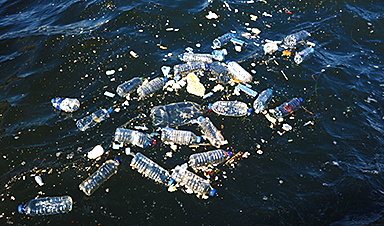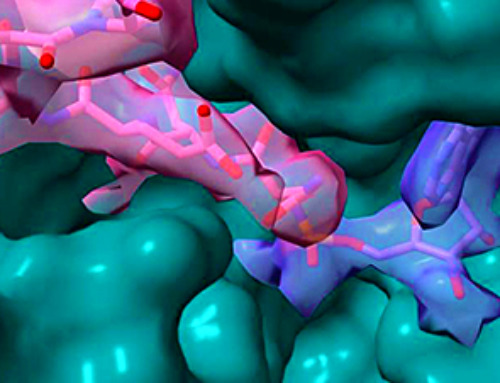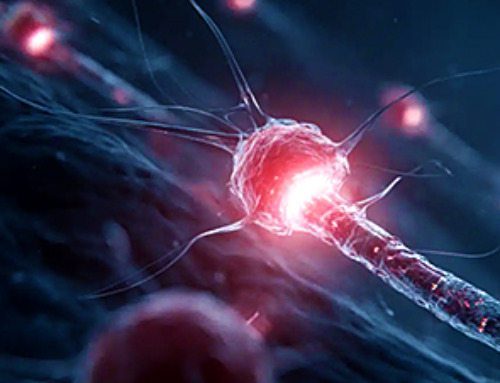Researchers at the Weizmann Institute have developed a biodegradable composite material that could play a significant role in addressing the global plastic waste crisis.
Billions of tons of plastic waste clutter our planet. Most of it accumulates on land, settles in the oceans, or disintegrates into tiny particles called microplastics, which pollute the air and water, infiltrating vegetation as well as the bloodstreams of humans and animals. The threat posed by plastics intensifies each year, as they are composed of massive molecules called polymers that resist biodegradation. Currently, biodegradable plastics account for less than one-fifth of total plastic production, and the processes required to break them down remain relatively cumbersome.
In a study published in ACS Nano, Dr. Angelica Niazov-Elkan, Dr. Haim Weissman and Prof. Boris Rybtchinski of the Molecular Chemistry and Materials Science Department at the Weizmann Institute of Science have created a new composite plastic that degrades easily using bacteria. This new material, produced by combining a biodegradable polymer with crystals from a biological substance, has three major benefits: It is cheap, easy to prepare, and very strong. Also participating in the study were the late Dr. Eyal Shimoni, Dr. XiaoMeng Sui, Dr. Yishay Feldman, and Prof. H. Daniel Wagner.
Currently, many industries are enthusiastically adopting composite plastics, which are made by combining two or more pure materials and possess the various beneficial properties such as lightness and strength. These plastics now serve to manufacture key parts of a wide variety of industrial products, from airplanes and cars to bicycles.
The Rise of Composite Plastics
Seeking to create a composite plastic that would meet the needs of industry while also being environmentally friendly, the Weizmann researchers decided to focus on commonplace, inexpensive source materials whose properties could be improved. They found that molecules of tyrosine – a prevalent amino acid that forms exceptionally strong nanocrystals – could be used as an effective component in a biodegradable composite plastic. After examining how tyrosine combines with several types of polymers, they chose hydroxyethyl cellulose, a derivative of cellulose, which is employed extensively in the manufacture of medicines and cosmetics.
On its own, hydroxyethyl cellulose is a weak material that disintegrates readily. To combine it with tyrosine, the two materials were mixed together in boiling water. When they cooled and dried, an exceptionally strong composite plastic was formed, made of fiber-like tyrosine nanocrystals that grew into the hydroxyethyl cellulose and integrated with it. In one experiment that revealed the new plastic’s strength, a 0.04-millimeter-thick strip of the material withstood a load of 6 kilograms.
Moreover, the team discovered that the new material had several other unique characteristics, making it even more useful for industry. Usually, when a material is strengthened, it loses plasticity.
Unique Properties and Industrial Potential
This new composite plastic, however, in addition to being very strong, is also more ductile (malleable) than its core component, hydroxyethyl cellulose. In other words, combining the two materials created a synergy that manifests itself in the emergence of extraordinary properties and, consequently, has massive industrial potential.
Since both cellulose and tyrosine – the crystals of which can be found in various types of hard cheese – are edible, the biodegradable composite plastic can actually be eaten. Is it also tasty? We will have to wait to find out: Since the production process in the lab is not hygienic enough for foodstuffs, the researchers are yet to have a nibble.
Rybtchinski sums up: “The follow-up study that we have already started could advance the commercial potential of this new material, since we have replaced the boiling in water with melting, as is more common in industry. This means that we heat up the biodegradable polymers until they become liquid and then mix in the tyrosine or other suitable materials. If we manage to overcome the scientific and technical challenges involved in this process, we will be able to explore the possibility of producing this new composite plastic on an industrial scale.”
Reference: “Emergent Self-Assembly of Sustainable Plastics Based on Amino Acid Nanocrystals” by Angelica Niazov-Elkan, Haim Weissman, Eyal Shimoni, XiaoMeng Sui, Yishay Feldman, H. Daniel Wagner and Boris Rybtchinski, 23 October 2023, ACS Nano.
DOI: 10.1021/acsnano.3c02528
Prof. Boris Rybtchinski’s research is supported by the Tom and Mary Beck Center for Advanced and Intelligent Materials and the Wolfson Family Charitable Trust & the Wolfson Foundation.
News
Team finds flawed data in recent study relevant to coronavirus antiviral development
The COVID pandemic illustrated how urgently we need antiviral medications capable of treating coronavirus infections. To aid this effort, researchers quickly homed in on part of SARS-CoV-2's molecular structure known as the NiRAN domain—an [...]
Drug-Coated Neural Implants Reduce Immune Rejection
Summary: A new study shows that coating neural prosthetic implants with the anti-inflammatory drug dexamethasone helps reduce the body’s immune response and scar tissue formation. This strategy enhances the long-term performance and stability of electrodes [...]
Scientists discover cancer-fighting bacteria that ‘soak up’ forever chemicals in the body
A family of healthy bacteria may help 'soak up' toxic forever chemicals in the body, warding off their cancerous effects. Forever chemicals, also known as PFAS (per- and polyfluoroalkyl substances), are toxic chemicals that [...]
Johns Hopkins Researchers Uncover a New Way To Kill Cancer Cells
A new study reveals that blocking ribosomal RNA production rewires cancer cell behavior and could help treat genetically unstable tumors. Researchers at the Johns Hopkins Kimmel Cancer Center and the Department of Radiation Oncology and Molecular [...]
AI matches doctors in mapping lung tumors for radiation therapy
In radiation therapy, precision can save lives. Oncologists must carefully map the size and location of a tumor before delivering high-dose radiation to destroy cancer cells while sparing healthy tissue. But this process, called [...]
Scientists Finally “See” Key Protein That Controls Inflammation
Researchers used advanced microscopy to uncover important protein structures. For the first time, two important protein structures in the human body are being visualized, thanks in part to cutting-edge technology at the University of [...]
AI tool detects 9 types of dementia from a single brain scan
Mayo Clinic researchers have developed a new artificial intelligence (AI) tool that helps clinicians identify brain activity patterns linked to nine types of dementia, including Alzheimer's disease, using a single, widely available scan—a transformative [...]
Is plastic packaging putting more than just food on your plate?
New research reveals that common food packaging and utensils can shed microscopic plastics into our food, prompting urgent calls for stricter testing and updated regulations to protect public health. Beyond microplastics: The analysis intentionally [...]
Aging Spreads Through the Bloodstream
Summary: New research reveals that aging isn’t just a local cellular process—it can spread throughout the body via the bloodstream. A redox-sensitive protein called ReHMGB1, secreted by senescent cells, was found to trigger aging features [...]
AI and nanomedicine find rare biomarkers for prostrate cancer and atherosclerosis
Imagine a stadium packed with 75,000 fans, all wearing green and white jerseys—except one person in a solid green shirt. Finding that person would be tough. That's how hard it is for scientists to [...]
Are Pesticides Breeding the Next Pandemic? Experts Warn of Fungal Superbugs
Fungicides used in agriculture have been linked to an increase in resistance to antifungal drugs in both humans and animals. Fungal infections are on the rise, and two UC Davis infectious disease experts, Dr. George Thompson [...]
Scientists Crack the 500-Million-Year-Old Code That Controls Your Immune System
A collaborative team from Penn Medicine and Penn Engineering has uncovered the mathematical principles behind a 500-million-year-old protein network that determines whether foreign materials are recognized as friend or foe. How does your body [...]
Team discovers how tiny parts of cells stay organized, new insights for blocking cancer growth
A team of international researchers led by scientists at City of Hope provides the most thorough account yet of an elusive target for cancer treatment. Published in Science Advances, the study suggests a complex signaling [...]
Nanomaterials in Ophthalmology: A Review
Eye diseases are becoming more common. In 2020, over 250 million people had mild vision problems, and 295 million experienced moderate to severe ocular conditions. In response, researchers are turning to nanotechnology and nanomaterials—tools that are transforming [...]
Natural Plant Extract Removes up to 90% of Microplastics From Water
Researchers found that natural polymers derived from okra and fenugreek are highly effective at removing microplastics from water. The same sticky substances that make okra slimy and give fenugreek its gel-like texture could help [...]
Instant coffee may damage your eyes, genetic study finds
A new genetic study shows that just one extra cup of instant coffee a day could significantly increase your risk of developing dry AMD, shedding fresh light on how our daily beverage choices may [...]





















